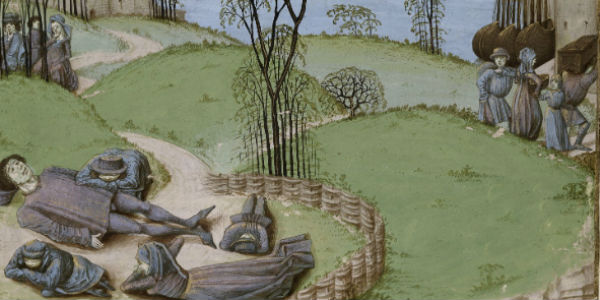Throughout history, only violent and catastrophic events have significantly cut inequality
Are mass violence and catastrophes the only forces that can seriously decrease economic inequality? To judge by thousands of years of history, the answer is yes, argues Walter Scheidel in this extract from his new book, The Great Leveller: Violence and the History of Inequality from the Stone Age to the 21st Century. Over thousands of years, only violent events have significantly lessened inequality. The “Four Horsemen” of levelling — mass-mobilisation warfare, transformative revolutions, state collapse, and catastrophic plagues—have repeatedly destroyed the fortunes of the rich.

Detail of a miniature of deaths from famine by Jean de Wavrin, between 1471-83. Image taken from f. 187 of Anciennes et nouvelles chroniques d’Angleterre, volume 1. British Library. Public domain
For thousands of years, civilisation did not lend itself to peaceful equalisation. Across a wide range of societies and different levels of development, stability favoured economic inequality. This was as true of Pharaonic Egypt as it was of Victorian England, as true of the Roman Empire as of the United States. Violent shocks were of paramount importance in disrupting the established order, in compressing the distribution of income and wealth, in narrowing the gap between rich and poor. Throughout recorded history, the most powerful levelling invariably resulted from the most powerful shocks. Four different kinds of violent ruptures have flattened inequality: mass mobilisation warfare, transformative revolution, state failure, and lethal pandemics. I call these the Four Horsemen of Levelling. Just like their biblical counterparts, they went forth to “take peace from the earth” and “kill with sword, and with hunger, and with death, and with the beasts of the earth.” Sometimes acting individually and sometimes in concert with one another, they produced outcomes that to contemporaries often seemed nothing short of apocalyptic. Hundreds of millions perished in their wake. And by the time the dust had settled, the gap between the haves and the have-nots had shrunk, sometimes dramatically.
Only specific types of violence have consistently forced down inequality. Most wars did not have any systematic effect on the distribution of resources: although archaic forms of conflict that thrived on conquest and plunder were likely to enrich victorious elites and impoverish those on the losing side, less clear-cut endings failed to have predictable consequences. For war to level disparities in income and wealth, it needed to penetrate society as a whole, to mobilise people and resources on a scale that was often only feasible in modern nation-states. This explains why the two world wars were among the greatest levellers in history. The physical destruction wrought by industrial-scale warfare, confiscatory taxation, government intervention in the economy, inflation, disruption to global flows of goods and capital, and other factors all combined to wipe out elites’ wealth and redistribute resources. They also served as a uniquely powerful catalyst for equalising policy change, providing powerful impetus to franchise extensions, unionisation, and the expansion of the welfare state. The shocks of the world wars led to what is known as the “Great Compression,” massive attenuation of inequalities in income and wealth across developed countries. Mostly concentrated in the period from 1914 to 1945, it generally took several more decades fully to run its course. Earlier mass mobilisation warfare had lacked similar pervasive repercussions. The wars of the Napoleonic era or the American Civil War had produced mixed distributional outcomes, and the farther we go back in time, the less pertinent evidence there is. The ancient Greek city-state culture, represented by Athens and Sparta, arguably provides us with earliest examples of how intense popular military mobilisation and egalitarian institutions helped constrain material inequality, albeit with mixed success.
The world wars spawned the second major levelling force, transformative revolution. Internal conflicts have not normally reduced inequality: peasant revolts and urban risings were common in premodern history but usually failed, and civil war in developing countries tends to render the income distribution more unequal rather than less. Violent societal restructuring needs to be exceptionally intense if it is to reconfigure access to material resources. Similarly to equalising mass mobilisation warfare, this was primarily a phenomenon of the twentieth century. Communists who expropriated, redistributed, and then often collectivised levelled inequality on a dramatic scale. The most transformative of these revolutions were accompanied by extraordinary violence, in the end matching the world wars in terms of body count and human misery. Far less bloody ruptures such as the French Revolution levelled on a correspondingly smaller scale.
Violence might destroy states altogether. State failure or systems collapse used to be a particularly reliable means of levelling. For most of history, the rich were positioned either at or near the top of the political power hierarchy or were connected to those who were. Moreover, states provided a measure of protection, however modest by modern standards, for economic activity beyond the subsistence level. When states unravelled, these positions, connections, and protections came under pressure or were altogether lost. Although everybody might suffer when states unraveled, the rich simply had much more to lose: declining or collapsing elite income and wealth compressed the overall distribution of resources. This has happened for as long as there have been states. The earliest known examples reach back 4,000 years to the end of Old Kingdom Egypt and the Akkadian empire in Mesopotamia. Even today, the experience of Somalia suggests that this once potent equalising force has not completely disappeared.
State failure takes the principle of levelling by violent means to its logical extremes: instead of achieving redistribution and rebalancing by reforming and restructuring existing polities, it wipes the slate clean in a more comprehensive manner. The first three horsemen represent different stages, not in the sense that they are likely to appear in sequence—whereas the biggest revolutions were triggered by the biggest wars, state collapse does not normally require similarly strong pressures—but in terms of intensity. What they all have in common is that they rely on violence to remake the distribution of income and wealth alongside the political and social order.
Human-caused violence has long had competition. In the past, plague, smallpox, and measles ravaged whole continents more forcefully than even the largest armies or most fervent revolutionaries could hope to do. In agrarian societies, the loss of a sizeable share of the population to microbes, sometimes a third or even more, made labor scarce and raised its price relative to that of fixed assets and other nonhuman capital, which generally remained intact. As a result, workers gained and landlords and employers lost as real wages rose and rents fell. Institutions mediated the scale of these shifts: elites commonly attempted to preserve existing arrangements through fiat and force but often failed to hold equalising market forces in check.
Pandemics complete the quartet of horsemen of violent levelling. But were there also other, more peaceful mechanisms of lowering inequality? If we think of levelling on a large scale, the answer must be no. Across the full sweep of history, every single one of the major compressions of material inequality we can observe in the record was driven by one or more of these four levellers. Moreover, mass wars and revolutions did not merely act on those societies that were directly involved in these events: the world wars and exposure to communist challengers also influenced economic conditions, social expectations, and policymaking among bystanders. These ripple effects further broadened the effects of levelling rooted in violent conflict. This makes it difficult to disentangle developments after 1945 in much of the world from the preceding shocks and their continuing reverberations. Although falling income inequality in Latin America in the early 2000s might be the most promising candidate for nonviolent equalisation, this trend has remained relatively modest in scope, and its sustainability is uncertain.
Other factors have a mixed record. From antiquity to the present, land reform has tended to reduce inequality most when associated with violence or the threat of violence—and least when not. Macroeconomic crises have only short-lived effects on the distribution of income and wealth. Democracy does not of itself mitigate inequality. Although the interplay of education and technological change undoubtedly influences dispersion of incomes, returns on education and skills have historically proven highly sensitive to violent shocks. Finally, there is no compelling empirical evidence to support the view that modern economic development, as such, narrows inequalities. There is no repertoire of benign means of compression that has ever achieved results that are even remotely comparable to those produced by the Four Horsemen.
Yet shocks abate. When states failed, others sooner or later took their place. Demographic contractions were reversed after plagues subsided, and renewed population growth gradually returned the balance of labor and capital to previous levels. The world wars were relatively short, and their aftereffects have faded over time: top tax rates and union density are down, globalisation is up, communism is gone, the Cold War is over, and the risk of World War III has receded. All of this makes the recent resurgence of inequality easier to understand. The traditional violent levellers currently lie dormant and are unlikely to return in the foreseeable future. No similarly potent alternative mechanisms of equalisation have emerged.
Even in the most progressive advanced economies, redistribution and education are already unable fully to absorb the pressure of widening income inequality before taxes and transfers. Lower-hanging fruits beckon in developing countries, but fiscal constraints remain strong. There does not seem to be an easy way to vote, regulate, or teach our way to significantly greater equality. From a global historical perspective, this should not come as a surprise. So far as we can tell, environments that were free from major violent shocks and their broader repercussions hardly ever witnessed major compressions of inequality. Will the future be different?
Excerpted from The Great Leveller: Violence and the History of Inequality from the Stone Age to the Twenty-First Century by Walter Schiedel. Copyright © 2017 by Princeton University Press. Reprinted by permission.
 Walter Scheidel is Dickason Professor in the Humanities and Professor of Classics and History at Stanford University.
Walter Scheidel is Dickason Professor in the Humanities and Professor of Classics and History at Stanford University.





 Democratic Audit's core funding is provided by the Joseph Rowntree Charitable Trust. Additional funding is provided by the London School of Economics.
Democratic Audit's core funding is provided by the Joseph Rowntree Charitable Trust. Additional funding is provided by the London School of Economics.